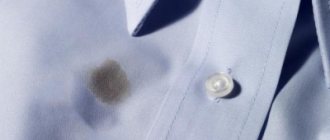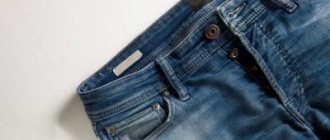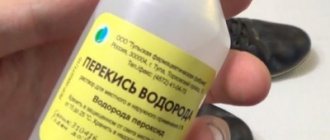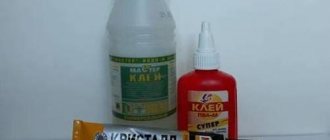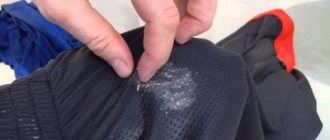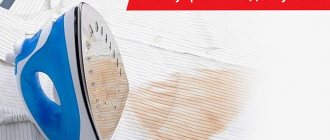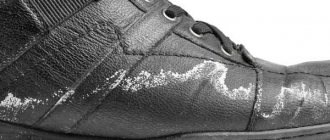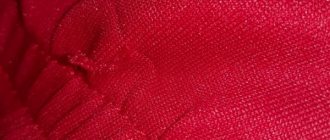Contacting fabric fibers, Whiteness discolors them, leaving white (and in some cases yellow) stains.
The problem of Whiteness stains can be solved only by restoring the color of the damaged area. Proven methods and recommendations from experienced housewives will help you do this correctly.
We will tell you further how to remove Whiteness stains from white, black and colored ones.
What happens when whiteness gets on clothes?
This chemical composition contains a large number of components that not only remove dirt from clothing, but also completely burn out its initial shade. When bleach comes into contact with fabric fibers, it discolors them, leaving unpleasant streaks on the surface. In some cases, such an impact leads to burning of the material.
If little time has passed since the whiteness got on the clothes, you can preserve the composition and shade of the fibers by treating the surface with a solution of sodium thiosulfate (1 teaspoon per 1 glass of water).
If the bleach is left on the item long enough, it will be nearly impossible to get rid of the stains. The only method will be to camouflage the affected area with improvised means.
What to do first?
The first thing to do when bleach gets on your clothes is to neutralize the effect of bleaching agents as soon as possible.
To do this, you need to carry out the following manipulations:
Thoroughly rinse traces of Whiteness on the fabric under running water. The goal is to rinse as much bleach out of the fibers as possible.- Without twisting the fabric, sprinkle a thick layer of baking soda on the stain. The goal is to neutralize the bleaching effect of Whiteness.
- Leave the layer of soda on the clothes until completely dry, then remove the powder with a soft brush.
It is necessary to begin neutralizing traces of bleach as soon as the bleach gets on the clothes. Delaying the process significantly reduces the chances of removing stains and restoring the original appearance of the clothing.
How long does it take to neutralize whiteness?
To avoid damage to the fabric item, you must immediately begin to neutralize the chlorine bleach. It is recommended to do this within 25-30 minutes of contact with the object. If you delay the process, the chances of removing contaminants will be reduced to zero. At the same time, using plain water to remove stains is ineffective - it will only help get rid of residual chemical components.
Ammonia
If a bleach mark appears on white items, it usually has a yellow tone that stands out brightly against the general background. The best way to get rid of the problem is ammonia. To remove yellowness, you need to do the following:
- Mix ammonia and water (proportion 1:1).
- Treat the yellowed area with the mixture.
- Rinse the product and wash with laundry soap or powder.
Aspirin can be used for a similar purpose. It should be crushed, combined with water and applied to the stain. After 15 minutes, wash the item. Both options work better on fresh damage.
Drops of bleach that fall on the material can dissolve the pigment contained in the fibers. An item that has discolored areas is most often thrown away, although you can try to bring it back to life using one of the simple methods of restoring the tone.
photo: depositphotos.com/diego_cervo
How to remove a fresh white stain
To remove a yellow stain on clothing, you need to perform the following manipulations:
- Rinse the affected area thoroughly under the tap. The main task is to remove as much of the chemical from the fabric fibers as possible.
- Treat the item with a thick layer of baking soda to neutralize the bleaching effect.
- Wait until the surface dries and remove the powder with a soft brush.
You can combat traces of whiteness on white fabrics with a household stain remover. If it is not effective, other proven methods should be considered.
Hydrogen peroxide
A small stain can be removed with hydrogen peroxide. The pharmaceutical product is inexpensive and available without a prescription. In addition to antiseptic properties, the composition is an effective bleach.
To process the matter, you need to prepare the peroxide itself, a cotton pad and a piece of laundry soap. The contaminated area should be rubbed with a cosmetic disc previously soaked in hydrogen peroxide. Next, you should lather the stain and wash it under cold tap water. If the stains do not disappear, the action will have to be repeated.
Hydrogen peroxide is used to treat fresh bleach marks.
Aspirin
Acetylsalicylic acid is also popular in the fight against whiteness stains. To remove contaminants, you need to prepare 2 aspirin tablets and grind them to a powder, and then dilute them with water. As a result of mixing the components, a thick consistency will appear, which should be distributed over the yellowish marks, rubbed in thoroughly and left to dry for 1-2 hours. After the specified period of time, the item must be washed and dried.
Aspirin is used in cases where the stain has been on the surface for more than 3 days.
Salt and alcohol
It is better to remove dirty marks on linen or cotton products with ammonia and table salt. The product is only suitable for natural fibers, but is not recommended for delicate fabrics, since large crystals can destroy the structure of the material.
To prepare the mixture, you need to mix 10 g of ammonia and 10 g of salt. Next, the consistency should be spread over the contaminated surface and left for 30–40 minutes. The last step is to wash the item with laundry soap.
Baking soda
The kitchen additive effectively removes stubborn stains with a brown or yellowish tint. To prepare the working composition, you need to take 20–25 g of powder and dilute it with water until a thick mass appears. Then the product should be applied to the item and left for 1-2 hours. Next, you need to rinse off any remaining baking soda with cold water.
Vinegar
If bleach has damaged a large area of clothing, simply painting over the stain will not correct the situation. To do this, you will need to thoroughly rinse the product in a cool liquid in which 1 tbsp is diluted. l. vinegar and then rinse with clean running water.
Salt and vinegar are used to fix the results after painting.
Starch
In most cases, the substance is used to clean fur products, since it has a gentle effect. To eliminate unpleasant marks, you need to straighten the item, then apply semolina or starch and moisten the surface with water. After this, you need to comb out the fur with a brush.
Dishwashing liquid
The detergent will help in removing white stains if used in a timely manner. To get a positive result, you need to treat the damaged area with dishwashing liquid. The composition is prepared at the rate of ½ tbsp. l. detergent per 240 ml of warm water. 5 minutes after treatment, the surface should be rinsed.
Change the color of the entire thing
This method may be required if the white has damaged a large surface area of the fabric and simple painting is not enough.
- You need to buy a specialized dye for dyeing fabrics.
- Make a dye solution following the instructions.
- Place the item of clothing in the solution, and for the best painting result, add salt.
- It is necessary to boil clothes or dye them at a temperature of 40-60 degrees.
- Leave the fabric in the dye solution for the specified time specified in the instructions.
- Then all that remains is to rinse the item in cool water with the addition of one tablespoon of vinegar.
Salt and vinegar should be used to fix the result after painting. But it is important to know that if a sufficiently large area of the fabric is damaged on clothes of dark shades, then the dyeing may be uneven. During subsequent washes, the shaded area will likely appear a lighter shade than the base color of the fabric. In such a situation, you should re-use the dye and process exactly this area of the fabric in order to match the color of the entire garment and the painted area as much as possible.
Removal depending on material and item
The effectiveness of removing yellow stains from clothing depends on the type of fiber and the degree of exposure to bleach. For different materials, appropriate cleaning methods are selected.
Jeans
The only option when denim items are stained with white is masking. Small areas can be painted over with a felt-tip pen or marker. If we are talking about removing a large stain, you will have to boil the fabric in hot water, following these instructions:
- The damaged item must be twisted (can be sealed with a rope or tied in a knot), and then placed in a pan filled with 10 liters of water.
- The liquid should be brought to a boil and add 250 ml of white and 2-3 tbsp. l. washing powder.
- Dip denim clothes into the prepared solution and boil for 20–25 minutes.
- Next, the denim pants or jacket must be straightened and rinsed under running water.
The effectiveness of the procedure depends on the time the whiteness is exposed to the clothes. The possibility of uneven digestion of the item cannot be ruled out.
To give damaged jeans a second life, you can remake them into “varenki”. To do this, heat the water in a large container, without bringing it to a boil, and dilute 1 tbsp in it. chlorine bleach.
Next, you need to boil the mixture and mix the contents thoroughly.
The next step is to twist the jeans in a chaotic way to get a non-standard effect, and put them in boiling water.
Processing takes from 20 minutes to 1 hour. The exact duration depends on the expected result.
Finally, remove the jeans from the container and rinse in cool water.
Natural fabrics
To combat yellow stains on white clothes made from natural fibers (silk, linen, cotton), you can use ammonia. However, if the composition is diluted with salt, special care must be taken in choosing the dosage. An aggressive mixture can destroy the fiber structure and damage the item.
To get rid of stains, you need to dilute ammonia and salt 1 tsp each. in a glass of warm water, and then apply to the yellow mark for 30-60 minutes. Finally, soak the material in a solution of laundry soap and wash it.
Delicate fabrics
If whiteness has damaged a product made from delicate fibers, you can use a proven folk remedy based on:
- 6 crushed tablets of hydroperite.
- 2 tsp. ammonia.
- 100 ml water.
Apply the resulting mixture to the affected area and wait 5 minutes. Then the item should be washed as usual.
Towels
In most cases, such products do not contain a large amount of dyes, so traces of whiteness cannot be removed with alcohol. Also, a marker is not suitable for masking, since the fabric has an uneven loop structure. Dyes can be used to restore the original appearance of towels.
In critical cases, the product should be completely soaked in white and the remaining paint should be removed.
This way you can get completely white towels that will be used for their intended purpose for quite a long time.
Shading
If the stain left on clothing by white occupies a very small area, then you should try to hide it using a marker or pencil of the same color as the item itself.
- You need to choose a pencil or marker of the same color as the damaged item.
- Next, you need to completely paint over the stain.
- Turn the damaged item of clothing inside out.
- Iron the painted area with an iron.
But if whiteness has damaged black fabric, then cosmetic mascara would be an excellent option. But drawing ink will cope with the task most efficiently. This artistic material is so absorbed into the fabric that it will never wash off the item of clothing, so there will be no need to adjust the area painted with it.
How to Remove Bleach Stains from Shoes
The method for removing traces of whiteness from shoes depends on the material from which it is made. In addition, the color of the spot is taken into account. If it is white, it means that the paint layer has been removed and the surface will have to be repainted. If it is yellow, you will need to remove the traces using traditional methods.
Fabric
Dirt on the fabric cannot return the original shade after washing and rinsing, since whiteness completely dissolves the pigment. Therefore, to restore the appearance of the shoes, you will need to use a marker. There are special tools for working with such material. If it is not possible to buy such a marker, you can use a simple alcohol-based stationery model.
If the fabric is plain, then removing the stain will be as simple as possible. It is enough to choose a suitable shade and paint over the area, moving from the edge of the affected area to the central part.
Suede
If whiteness gets on shoes made of this material, you must do the following:
- Sprinkle the stain with talcum powder, after moistening the area with water.
- Wait until the mixture dries and clean the shoes with a brush.
- Replace the talc with soda or potato starch and repeat the procedure.
- Combine 1 tbsp. l. food additives with 1 liter. skim milk.
- Treat the stained area with a cotton pad soaked in the prepared solution, and after 2 minutes wipe with a soft cloth.
Leather
In most cases, washing leather shoes is done by dry cleaning, since this is the most effective, but expensive method.
An indispensable remedy for stains on shoes is baking soda. To prepare the composition, you need to dilute the food additive in water until a paste-like consistency appears, then apply it to the brush and carefully wipe the product. The remaining solution should be removed using a cloth scrap.
But you should not abuse soda and use it more than once a month.
How to eliminate on color?
The easiest way to restore the brightness of colors in discolored areas of colored clothing is to use special permanent markers.
Among the wide range of markers presented on the shelves of haberdashery stores, everyone will be able to find the option they need. The main thing is to choose the right marker color that matches the tone of the damaged fabric.
If the colored fabric is slightly damaged, alcohol will help to mask traces of whiteness. To do this, moisten the outline of the stain with a cotton swab, generously moistened with alcohol. After a few minutes, carefully using a cotton swab, the coloring pigment softened with alcohol is redistributed over the whitish spot from the Whiteness. This method is most effective for fabrics with unstable dyeing.
What to do with old bleach stains on white clothes
There are several stain removers that can help remove stubborn chlorine bleach stains. They are used in critical cases when folk remedies are powerless.
Vanish Gold Oxi Action
The composition effectively fights stains of any complexity, including traces of bleach. To remove stains, you need to soak clothes in water with dissolved Vanish Gold Oxi Action (the ratio of components is indicated on the package) and leave for 1 hour. Then the product should be washed as usual.
The product contains active oxygen and enzymes that do not harm the structure of the fibers. The average price of bleach is 1000 rubles. for a container weighing 1000 g.
Clean Home
High-quality bleaching powder that provides quick cleaning of clothes from stubborn and difficult stains. The stain remover contains active oxygen, which enhances the effectiveness of the treatment. You can buy a container with 1000 g of the substance for 600 rubles.
Frosch
The drug is produced by a German company and is intended for pre-treatment of contaminants. The main active ingredient is citric acid citrate, which ensures the fastest and most effective removal of stains and yellowness from white things. Frosch can be used on all types of fibers, including delicate fabrics. The cost of the product does not exceed 160 rubles. for 750 ml.
Why didn’t things bleach, but changed color in spots?
Such problems arise due to incorrect dyeing technology. A uniform color can only be achieved this way:
Wrap things tightly before bleaching;
Stir constantly during cooking (in a bucket), distribute the composition evenly over the surface (method without using water);
Follow the instructions on the packaging of the dye or bleach;
Rinse clothes for at least 5 minutes in cold water.
Do you know another way? Share it in the comments!
If you use bleach very often when washing white clothes, then there is a high risk that white stains from the bleach itself will soon appear on your clothes. Stains may appear due to: incorrect proportion of the substance, soaking for too long, or frequent use of one product. To solve the problem of how to remove white stains, just read our recommendations carefully and choose the appropriate cleaning method. Let's get started.
How to remove whiteness from black fabrics
Chlorine bleach leaves unpleasant white marks on black items. They can only be removed by painting, using special dyes that are sold in stores.
The processing principle is quite simple:
- A dye of a suitable shade should be dissolved in water, following the manufacturer's instructions.
- Place the item damaged by bleach into the resulting consistency and bring to a boil.
- Rinse the painted product in cold water and vinegar (2-3 teaspoons of vinegar are required for 1 liter of water).
Painting with special compounds must be carried out strictly according to the manufacturer’s instructions. If you don’t have the time or opportunity to buy store-bought dyes, you can remove stains with mascara. The product penetrates deeply into the fibers and provides effective dyeing of discolored areas in a contrasting black color. The processing result is preserved for a long time.
IDEAL Back to Black
It is a special composition for restoring black tissues that have been damaged by chlorine substances. Suitable for most fiber types. After processing, the product does not lose texture and does not fade. You can buy IDEAL Back to Black for 680 rubles. (400 g).
Simplicol Intensiv
Used for uniform coloring of bleached black products made from natural and synthetic materials. To restore the shade of the fibers, you need to place the clothes in the washing machine, add a packet of liquid mixture and start the wash cycle at a temperature of +4 ° C. There is no need to dilute the dye with the powder.
After such treatment, the clothes do not fade and acquire their original appearance. The cost of a package of dye (400 g) is 650 rubles.
Marabu
The powder is used for both manual and machine processing. After restoration, the shade of the fabric does not fade and remains resistant to frequent washing. The product removes marks on any type of fiber.
The dye is sold at a price of 560 rubles. per package 30 g.
How to save jeans?
It will not be possible to revive denim fabric if the bleach has become deeply ingrained. A small spot is painted over with a pencil, pen, or felt-tip pen. If the affected area is large, then the only option is to reclassify the jeans as “dumplings.”
Cover the stain with applique
To do this you will need whitening powder and water. Heat a bucket of water to a boil, add the powder, cook the jeans rolled vertically in the mixture for about 15 minutes. After the procedure, jeans should be rinsed in cold water. Dyeing is not recommended: if most of the item is damaged, it may be uneven.
An excellent solution is to disguise the stain with an applique or patch, pocket or patch, or make torn holes. It all depends on the style of the product.
Universal ways to get rid of white stains on black and colored
If the contact of chlorine bleach with an item of clothing or shoes was short, you can use several universal methods for removing stains. With their help, it is possible to restore the color of the fabric or disguise a defective area.
Color over with marker
To mask stains from whiteness, a pencil or marker with a suitable shade that matches the shade of the surface is suitable. To carry out the procedure, you need to carefully sketch the affected area, turn the item inside out and apply a damp piece of cotton fabric to the wrong side and smooth it with an iron.
The painting method is effective when the bleach has damaged a small area. If the whiteness appears on black fabric, then you should use cosmetic mascara or drawing mascara. The artistic composition is strongly absorbed into the fabric, covering the defective area, and is never washed off again. As a result, the owner of the item will not have to re-correct the painted area.
Dyeing clothes
If the bleach has damaged most of the fabric item, it will need to be completely redyed. To do this you need:
- Buy a special dye for the appropriate type of fiber.
- Dilute the mixture in water following the manufacturer's instructions.
- Dip the product into the solution (you can add salt to it for better coloring).
- Boil the item or paint it at a temperature of +40…+60 °C.
- Wait the required time (indicated on the label) and remove the painted item from the container.
- Rinse clothes in cold liquid adding 1 tbsp. l. vinegar.
It must be borne in mind that vinegar and salt have fixing properties. If a large area has been damaged on a dark item, the coloring may turn out uneven. During subsequent washes, the area will be highlighted with a light shade. To eliminate the problem, you should treat the damaged area with dye again to even out the color.
Embroidery or patch
A damaged piece of clothing can be repaired with embroidery. You can also disguise the area with an applique or a sewn pocket. If there are drops of bleach on a pocket, cuff, belt or collar, you can replace these elements without much difficulty.
First of all, you will need to wash the stained part, select a compatible material, make a pattern and sew the area in place. If you do not have the skills to carry out such procedures, you should seek help from a studio or an experienced seamstress.
To make the stain invisible, you can buy threads and stitch in the desired place, using the criss-cross method or along and across.
Such a patch will not only hide dirt, but also decorate your clothes. The main thing is to show a little imagination.
Adviсe
If Whiteness has damaged a collar, pocket or cuff, a complete replacement of the damaged part can revive your favorite item .
If you don’t have a marker at hand, drawing ink can replace it. It is enough to dip a thin brush into the mascara or refill a special fountain pen.
Then carefully (trying not to go beyond the outline) shade the white spots on the black fabric.
Get rid of after washing
If, after washing, your favorite wardrobe item does not get the desired appearance, and is full of stains from powder, detergent, or whiteness, we recommend resorting to the following, no less original methods.
Method No. 1
If a small, barely noticeable stain appears on your favorite T-shirt, but its very appearance causes negative emotions, inspect the item and evaluate the color. Select a felt-tip pen or marker to match the color of the damaged item and carefully, pointwise, paint over the area affected by bleach. After light “makeup”, iron the affected area through a piece of cloth so that the excess dye is absorbed into it.
This is interesting: How to remove stains of unknown origin from raincoat fabric
Method No. 2
This method is more suitable for youth T-shirts, which, even at the production stage, are painted with all sorts of colors, deliberately creating stains and streaks.
To carry out this kind of resuscitation efficiently, you will need fabric paint.
In any sewing store you can find all kinds of colors and shades.
Natural fabrics lend themselves best to resuscitation in this way.
Method No. 3
This method is only slightly different from the previous one: to perform it correctly, you will have to go to a fabric store or a nail store and buy acrylic paint in tubes (which is important).
The viscous consistency of this type of paint will allow you to independently draw an applique, a pattern that will cover up, and maybe even organically play up the stain from the cleaning agent.
After the acrylic paint has completely dried on the product, you need to take a piece of cloth, cover the painted area and iron it. Once heated, the acrylic paint will firmly adhere to dense fabric and the pattern you apply yourself will delight you for a long time!
This method is suitable for all types of tissue, but it is best to carry out such resuscitation on rough tissues.
Method No. 4
Suitable for creative people who know how to embroider with thread or ribbons. It’s very beautiful when a bleach stain on a blouse is skillfully hidden under neat embroidery, especially considering that in recent years embroidery has remained quite a fashionable and stylish wardrobe detail. Perhaps a speck of bleach or Domestos will encourage you to create an incredibly fashionable masterpiece?
Method No. 5
This is the easiest and fastest method and is suitable for almost all types of fabrics that can be heated. In order to save your item, you just need to buy a patch at any hardware store. Then, at home, you smooth out the damaged item, put the patch you like on it and iron it thoroughly. Fast and convenient!
Remove on dark stain remover
There is another, no less important problem that needs to be dealt with – stain remover stains. It sounds like a pun, but in reality they are the most difficult to deal with.
First of all, you should take into account the type of stain remover you are purchasing, that is, you should understand them in advance. It is important to remember that no matter what the advertising on TV says, there are no stain removers that can remove absolutely all stains without exception.
These funds are divided into several specially targeted groups - you need to know this. For example, a marker remover will not be able to remove a ketchup stain on black trousers, and a stain remover for delicate fabrics will not cope with severe repair stains on rough work uniforms.
Above all else, the most important thing to remember is timely intervention.
After all, the longer the stain remains on the surface of the clothing, the more difficult it is to remove.
When washing in the washing machine, ensure that the required temperature is maintained.
If, after proper washing, the unpleasant mark still appears on the clothes, resort to a full wash again.
Another important tip that should not be neglected, because it prevents an unpleasant problem from arising, is to test the stain remover on an inconspicuous area of the fabric.
You need to start treating the stain from the edges, otherwise there is a risk that it will spread over a larger area.
Important! After removing the stain with a stain remover, you need to thoroughly rinse the clothes in warm water so as not to encounter a new problem - a stain from the stain remover.
As a last resort, take your clothes to the dry cleaner.
Restoring color using paint
There are two ways to use dye to remove bleach stains. You can paint only the spot where the color is missing, or paint the entire product. For best results, it is best to paint the entire piece.
- Find a dye at a craft store or supermarket that is as close as possible to the color of the bleach-damaged item.
- Before you start painting the product, remove the color using a special product (sold there).
- Follow the instructions on the product label and paint the item.
- After the product has dried, it is recommended to treat it with a color fixing agent.
